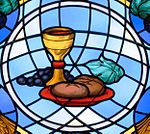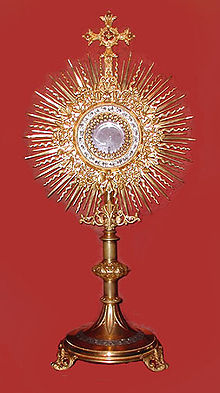| Revision as of 03:43, 2 January 2007 edit68.223.244.141 (talk) →History← Previous edit | Revision as of 22:38, 4 January 2007 edit undoChooserr (talk | contribs)3,619 edits →Roman Catholic belief: rm - the last sentence has nothing to do with the catholic belief, but instead opinions concerning the catholic beliefNext edit → | ||
| Line 16: | Line 16: | ||
| === Roman Catholic belief === | === Roman Catholic belief === | ||
| In the Roman Catholic tradition, at the moment of ] the elements (or "gifts" as they are termed for liturgical purposes) are transformed (literally ]) into the actual Body and Blood of Christ. Catholic doctrine holds that the elements are not only spiritually transformed, but rather are actually (]) transformed into the Body and Blood of Christ. It is held that although the elements retain the appearance or "]" of bread and wine, they are indeed the actual Body, Blood, Soul, and Divinity of Christ. This is one form of the doctrine of ]—the actual, substantive presence of ] in the ]. At the point of ], the act that takes place is a double miracle: 1) that Christ is present in a physical form and 2) that the bread and wine have truly, substantially become Jesus' Body and Blood. Because Roman Catholics believe that Christ is truly present (Body, Blood, Soul and Divinity) in the Eucharist, the reserved sacrament serves as a focal point of adoration |
In the Roman Catholic tradition, at the moment of ] the elements (or "gifts" as they are termed for liturgical purposes) are transformed (literally ]) into the actual Body and Blood of Christ. Catholic doctrine holds that the elements are not only spiritually transformed, but rather are actually (]) transformed into the Body and Blood of Christ. It is held that although the elements retain the appearance or "]" of bread and wine, they are indeed the actual Body, Blood, Soul, and Divinity of Christ. This is one form of the doctrine of ]—the actual, substantive presence of ] in the ]. At the point of ], the act that takes place is a double miracle: 1) that Christ is present in a physical form and 2) that the bread and wine have truly, substantially become Jesus' Body and Blood. Because Roman Catholics believe that Christ is truly present (Body, Blood, Soul and Divinity) in the Eucharist, the reserved sacrament serves as a focal point of adoration. | ||
| === Anglican belief === | === Anglican belief === | ||
Revision as of 22:38, 4 January 2007
| Part of a series on the |
| Eucharist |
|---|
 |
| Elements |
| Ritual and liturgy |
| Practices and customs |
| History |
| Theology |
| Denominational teachings |
| Related articles |
Eucharistic adoration is a practice in the Roman Catholic and in Anglican Churches, in which the Blessed Sacrament is exposed to and adored by the faithful. When this exposure and adoration is constant (that is, twenty-four hours a day), it is called perpetual adoration. In a parish, this is usually done by volunteer parishioners; in a monastery or convent, it is done by the resident monks or nuns.
History
The practice of adoration traces its roots to the fact that in monasteries and convents the Blessed Sacrament was an integral part of the structure of cloistered life. From the beginning of community life the Eucharist was originally kept in a special room, just off the sanctuary but separated from the church where Mass was offered. A variety of names was used to identify this place of reservation, Pastoforium, diakonikon, secretarium, prothesis are the most common. One of the first unmistakable references to reserving the Blessed Sacrament for adoration is found in a life of St. Basil (who died in 379). Basil is said to have divided the Eucharistic Bread into three parts when he celebrated Mass in the monastery. One part he consumed, the second part he gave to the monks, and the third he placed in a golden dove suspended over the altar .
The lay practice of adoration formally began in Avignon, France on September 11, 1226. To celebrate and give thanks for the victory over the Albigensians in the later battles of the Albigensian Crusade, King Louis VII asked that the sacrament be placed on display at the Chapel of the Holy Cross. The overwhelming number of adorers brought the local bishop, Pierre de Corbie, to suggest that the exposition be continued indefinitely. With the permission of Pope Honorius III, the idea was ratified and the adoration continued there practically uninterrupted until the chaos of the French Revolution halted it from 1792 until the efforts of the "Confraternity of Penitents-Gris" brought it back in 1829 .
Mother Mechtilde of the Blessed Sacrament pioneered perpetual adoration of the Eucharist on request of Père Picotte. The Benedictine convent, founded for this purpose, opened in France on March 25, 1654.
Another common early practice of adoration is Quarantore an exercise of devotion in which continuous prayer is made for forty hours before the exposed Blessed Sacrament. This is said to have started in Milan in May 1537
At 128 years and counting, the Franciscan Sisters of Perpetual Adoration have been praying nonstop longer than anyone in the United States. The practice began on August 1, 1878, at 11 a.m. and continues to this date
Purpose of adoration
Adoration is a sign of devotion to and worship of Jesus Christ, who is believed by many Christians to be present in the consecrated host, represented by hosts or bread.
Roman Catholic belief
In the Roman Catholic tradition, at the moment of Consecration the elements (or "gifts" as they are termed for liturgical purposes) are transformed (literally transubstantiated) into the actual Body and Blood of Christ. Catholic doctrine holds that the elements are not only spiritually transformed, but rather are actually (substantially) transformed into the Body and Blood of Christ. It is held that although the elements retain the appearance or "accidents" of bread and wine, they are indeed the actual Body, Blood, Soul, and Divinity of Christ. This is one form of the doctrine of Real Presence—the actual, substantive presence of Jesus in the Eucharist. At the point of Consecration, the act that takes place is a double miracle: 1) that Christ is present in a physical form and 2) that the bread and wine have truly, substantially become Jesus' Body and Blood. Because Roman Catholics believe that Christ is truly present (Body, Blood, Soul and Divinity) in the Eucharist, the reserved sacrament serves as a focal point of adoration.
Anglican belief
Opinions on the nature of the Eucharist and thus on the propriety of adoration of the Blessed Sacrament vary in the Anglican tradition (see Anglican Eucharistic theology).
Lutheran belief
Lutheran Eucharistic adoration is almost always limited in duration to the communion service because Lutheran tradition does not include reservation of the Sacrament. However, at this time, in North America, the Evangelical Community Church-Lutheran and some other small Churches in the Lutheran Evangelical Catholic Tradition (High Church Lutheran), do reserve the Sacrament, and strongly encourage Eucharistic adoration without requiring it.
Historically in Lutheranism there have been two parties regarding Eucharistic adoration: Gnesio-Lutherans, who followed Martin Luther's view in favor of adoration and Philippists who followed Philipp Melanchthon's view against it. Although Luther did not approve of the Feast of Corpus Christi , he wrote a treatise "Adoration of the Sacrament" (Von anbeten des sakraments des heyligen leychnahms Christi, 1523) where he defended adoration but desired that the issue not be forced. After the death of Martin Luther, further controversies developed including Crypto-Calvinism and Gnesio-Lutheranism. Philippist understanding of the Real Presence without adoration through time became dominant in Lutheranism, although it is not in accordance with Luther's original teaching. German theologian Andreas Musculus can be regarded as one of the warmest defenders of Eucharistic adoration in early Lutheranism .
The practice of adoration

The host is displayed in a monstrance, typically placed on an altar. The Blessed Sacrament may not actually be exposed, but left in a ciborium, which is likewise placed on an altar. This exposition usually occurs in the context of a service of Benediction or similar service of devotions to the Blessed Sacrament. In services of perpetual adoration, parishioners volunteer to attend for a certain period of time, typically an hour, around the clock. Because of the difficulty of maintaining twenty-four hour attendance, many parishes no longer provide perpetual adoration. In many parishes, the Blessed Sacrament is reserved in an enclosed tabernacle so that the faithful may pray in its presence without the need for volunteers to be in constant attendance (as must be the case when the Blessed Sacrament is exposed).
Source
References
- Corpus Christi article in Christian Cyclopedia
- Venerable
External links
- "Network of Eucharistic Adoration"
- The Reservation and Veneration of the Most Holy Eucharist from the Catholic Code of Canon law
- New Advent on Perpetual Adoration
- Location of Eucharistic Adoration sites
- The History of Eucharistic Adoration by Fr. John A. Hardon, S.J. in PDF format
- St. Martin of Tours Roman Catholic Church, Louisville, Kentucky's online perpetual adoration.